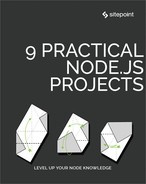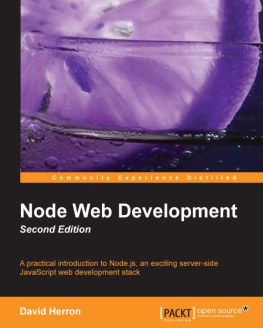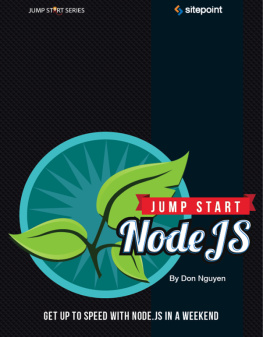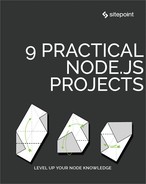9 Practical Node.js Projects
Copyright 2018 SitePoint Pty. Ltd.
- Cover Design: Alex Walker
Notice of Rights
All rights reserved. No part of this book may be reproduced, stored in a retrieval system or transmitted in any form or by any means, without the prior written permission of the publisher, except in the case of brief quotations embodied in critical articles or reviews.
Notice of Liability
The author and publisher have made every effort to ensure the accuracy of the information herein. However, the information contained in this book is sold without warranty, either express or implied. Neither the authors and SitePoint Pty. Ltd., nor its dealers or distributors will be held liable for any damages to be caused either directly or indirectly by the instructions contained in this book, or by the software or hardware products described herein.
Trademark Notice
Rather than indicating every occurrence of a trademarked name as such, this book uses the names only in an editorial fashion and to the benefit of the trademark owner with no intention of infringement of the trademark.

Published by SitePoint Pty. Ltd.
48 Cambridge Street Collingwood
VIC Australia 3066
Web: www.sitepoint.com
Email: books@sitepoint.com
About SitePoint
SitePoint specializes in publishing fun, practical, and easy-to-understand content for web professionals. Visit http://www.sitepoint.com/ to access our blogs, books, newsletters, articles, and community forums. Youll find a stack of information on JavaScript, PHP, design, and more.
Preface
While there have been quite a few attempts to get JavaScript working as a server-side language, Node.js (frequently just called Node) has been the first environment that's gained any traction. It's now used by companies such as Netflix, Uber and Paypal to power their web apps. Node allows for blazingly fast performance; thanks to its event loop model, common tasks like network connection and database I/O can be executed very quickly indeed.
From a beginner's point of view, one of Node's obvious advantages is that it uses JavaScript, a ubiquitous language that many developers are comfortable with. If you can write JavaScript for the client-side, writing server-side applications with Node should not be too much of a stretch for you.
In this book, we'll offer a selection of nine different practical projects that you can follow along with.
Who Should Read This Book?
This book is for anyone who wants to start learning server-side development with Node.js. Familiarity with JavaScript is assumed, but we don't assume any previous back-end development experience.
Conventions Used
Code Samples
Code in this book is displayed using a fixed-width font, like so:
A Perfect Summer's Day
It was a lovely day for a walk in the park.The birds were singing and the kids were all back at school.
Where existing code is required for context, rather than repeat all of it, will be displayed:
function animate() { new_variable = "Hello";}Some lines of code should be entered on one line, but weve had to wrap them because of page constraints. An indicates a line break that exists for formatting purposes only, and should be ignored:
URL.open("http://www.sitepoint.com/responsive-web-design-real-user-testing/?responsive1");Youll notice that weve used certain layout styles throughout this book to signify different types of information. Look out for the following items.
Tips, Notes, and Warnings
Hey, You!
Tips provide helpful little pointers.
Ahem, Excuse Me ...
Notes are useful asides that are relatedbut not criticalto the topic at hand. Think of them as extra tidbits of information.
Make Sure You Always ...
... pay attention to these important points.
Watch Out!
Warnings highlight any gotchas that are likely to trip you up along the way.
Chapter 1: Build a Simple Beginner App with Node, Bootstrap & MongoDB
by James Hibbard
If youre just getting started with Node.js and want to try your hand at building a web app, things can often get a little overwhelming. Once you get beyond the "Hello, World!" tutorials, much of the material out there has you copy-pasting code, with little or no explanation as to what youre doing or why.
This means that, by the time youve finished, youve built something nice and shiny, but you also have relatively few takeaways that you can apply to your next project.
In this tutorial, Im going to take a slightly different approach. Starting from the ground up, Ill demonstrate how to build a no-frills web app using Node.js, but instead of focusing on the end result, Ill focus on a range of things youre likely to encounter when building a real-world app. These include routing, templating, dealing with forms, interacting with a database and even basic authentication.
This wont be a JavaScript 101. If thats the kind of thing youre after, look here. It will, however, be suitable for those people who feel reasonably confident with the JavaScript language, and who are looking to take their first steps in Node.js.
What Well Be Building
Well be using Node.js and the Express framework to build a simple registration form with basic validation, which persists its data to a MongoDB database. Well add a view to list successful registration, which well protect with basic HTTP authentication, and well use Bootstrap to add some styling. The tutorial is structured so that you can follow along step by step. However, if youd like to jump ahead and see the end result, the code for this tutorial is also available on GitHub.
Basic Setup
Before we can start coding, well need to get Node, npm and MongoDB installed on our machines. I wont go into depth on the various installation instructions, but if you have any trouble getting set up, please leave a comment below, or visit our forums and ask for help there.
Node.js
Many websites will recommend that you head to the official Node download page and grab the Node binaries for your system. While that works, I would suggest that you use a version manager instead. This is a program which allows you to install multiple versions of Node and switch between them at will. There are various advantages to using a version manager, for example it negates potential permission issues which would otherwise see you installing packages with admin rights.
If you fancy going the version manager route, please consult our quick tip: Install Multiple Versions of Node.js Using nvm. Otherwise, grab the correct binaries for your system from the link above and install those.
npm
npm is a JavaScript package manager which comes bundled with Node, so no extra installation is necessary here. Well be making quite extensive use of npm throughout this tutorial, so if youre in need of a refresher, please consult: A Beginners Guide to npm the Node Package Manager.
MongoDB









